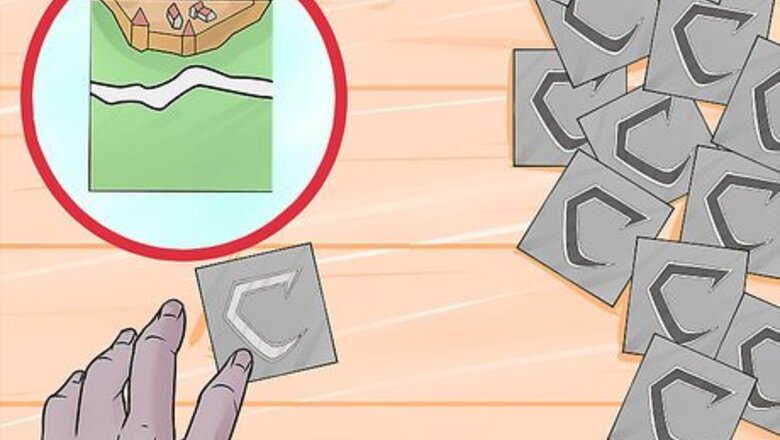
views
Carcassonne Game Setup
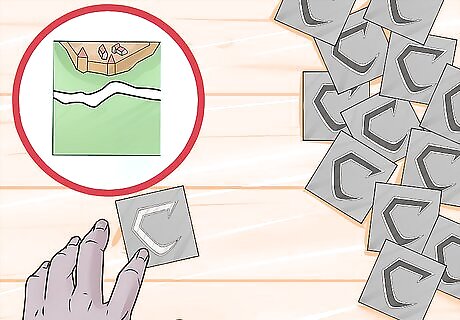
Place the starting tile in the middle of the table. When you open a game of Carcassonne, look for the starting tile with the darker back. Set the tile face-up where all the players are able to reach it. Use a large table or other playing space to play Carcassonne because the tiles will sprawl out and take up quite a bit of space.
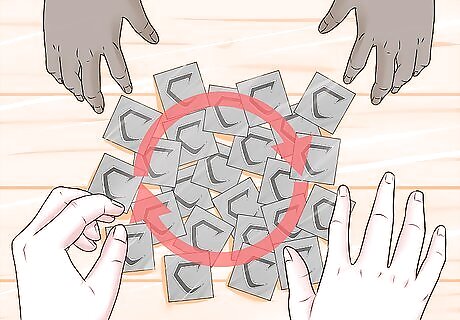
Shuffle and stack the remaining tiles face down. Mix up all the tiles and form them into a couple even stacks around the table. Make sure all the players are able to reach a stack so they can draw tiles throughout the game. Alternatively, toss the tiles into a cloth bag, shake them up, and draw them at random without looking during the game.
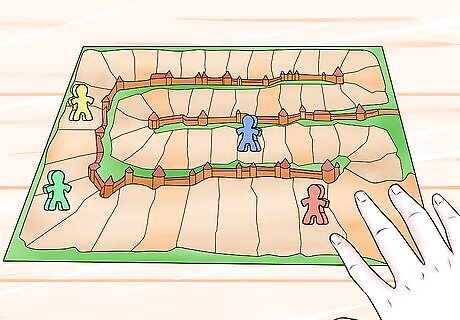
Place a meeple on the scorecard for each player. Give each player all of the wooden meeples of their chosen color for their personal supply. Place the scorecard near the edge of the table. Have each player put a meeple on the “0” space of the scorecard. You can play Carcassonne with 2-5 players. Two-player games are more head-to-head while more players make the game a little more random. Each player is responsible for tracking their own points, or you can have whoever’s sitting closest track the score.
Pick a player at random to go first. Any player can volunteer to go first, or you can choose someone at random. You may have the youngest player go first, or let the person who won the last game start. From start to finish, a game of Carcassonne usually takes around 30-45 minutes to play.
Carcassonne Gameplay
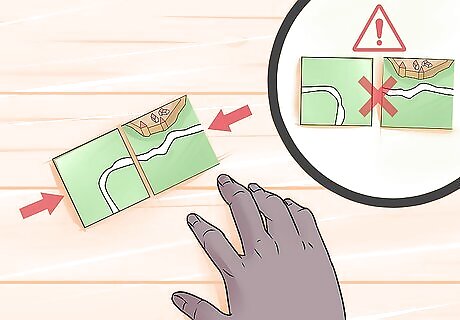
Play a tile so the edge features match one that’s already been played. Draw a tile from one of the stacks and place it adjacent to an existing tile. Tiles have features like green fields, white roads, and brown cities. When you place a tile, the features must match along any touching edges for it to be a legal move. Example: If the tile you drew has a road connecting to one edge, you may play it onto an open edge with a road. On later turns, the tile you place must match existing tiles on each side they touch. If an open space connects to a field on the left and a road on top, then the tile you play must line up with those features.

Place a meeple on the tile you played to claim empty features. If the tile you just played has a road, city, or monastery (church) on it, then you may take a meeple from your supply and stand it up on the tile. Placing a meeple lets you claim the feature so you’re able to score it later in the game. If the feature on a tile you played connects to one that’s already been claimed by another player, you cannot put another meeple on it.
Score any roads, cities, or monasteries you completed. If playing a tile closes or completes a feature that already has a meeple on it, then it immediately scores regardless of whose turn it is. Add the points to your score card by moving your meeple up the track on the scorecard. After scoring points, players take their meeples off the board and put them back into their personal supply. Roads: Score a road once both ends are closed or connected to a different feature. Earn 1 point for each tile in the road. Cities: Score cities when they’re completely enclosed without any gaps inside. Earn 2 points for each tile in the city, and an additional 2 points for each coat of arms (shield) icon within the city walls. Monasteries: Score a monastery once it is completely surrounded by 8 tiles. Earn 1 point for the Monastery and each tile surrounding it (for a total of 9 points).
Final Scoring & Winning the Game

Take turns until you run out of tiles. Players continue taking turns going clockwise around the table. Players always have to play a tile on their turn, even if it doesn’t directly benefit them or add to their score. As soon as all of the tile stacks have run out, the game immediately ends. If at any point you draw a tile that you cannot place because it won’t fit anywhere, make sure your fellow players agree that there is nowhere to place the tile. In the rare case that there’s no legal spot for the tile, put it back in the box and draw a new one.
Earn points for incomplete features. Check the tiles for any meeples that are still on the board and tally up the points for the remaining features. As you score each remaining feature, remove the meeple from the board so you don’t accidentally count it again. Roads: Earn 1 point for each tile in the incomplete road Cities: Earn 1 point for each tile in the city, and an additional 1 point for each coat of arms icon Monasteries: Earn 1 point for the Monastery and each tile surrounding it (for a total of up to 9 points)
Win the game if you earn the most points. Move meeples around the track on the scorecard to count up the final points. Whoever earned the most points from scoring features wins the game! If there’s a tie for points, then the tied players share the win.
Advanced Rules
Place a meeple in a field next to completed cities to score endgame points. After you play a few games with the basic rules, then include the option to claim fields during your turn. Lay the meeple flat on an unclaimed field and leave it there for the remainder of the game. At the end of the game, you earn 3 points for every completed city adjacent to the field you claimed. Just like other features, you cannot play a meeple on a field if another player has already put one there.
Start the game with the River tiles for more variety on the board. Use the river’s “Source” tile instead of the original starting tile and set aside the “Lake” tile. Shuffle the remaining River tiles and place them face-down. Start the game as normal, using all of the River tiles before any of the game tiles. The River tiles add new areas to place tiles at the start of the game so you have more options for playing. When you place River tiles, you can never place them so they turn twice in the same direction and create a U-turn.
Place Abbots on monasteries or gardens for bonus scoring opportunities. Abbots are wooden meeples that have a pointed top. Whenever you place a tile with a monastery or a picture of a flower garden, you may place an Abbot instead of a meeple. When you surround a tile with an Abbot with 8 other tiles, they score 9 points like a normal monastery and return to your supply. Instead of placing a meeple on your turn, you may instead pick up an Abbot you already placed. Earn points for the number of tiles that were surrounding the Abbot, including the one it was on.
Winning Strategies
Play a tile to connect and score features that already have meeples. Instead of connecting a tile to a feature that’s already claimed, place your tile nearby so you can place a meeple on it. On a later turn, try to place another tile that connects the features together so you can also earn points from it. Example: If another player puts their meeple on a road, place a road tile a space or two away and put one of your meeples on the road. If you draw another road tile on a later turn, use it to connect the tiles with the meeples on it. Whoever has the most meeples in a feature scores points for it. If players are tied for the number of meeples on a feature, then they all earn the full points for that feature. In games with more than 2 players, work together to collaborate on some shared features. That way, you can earn more points than if you were making smaller features alone.
Place tiles to block your opponents from finishing features. If you notice other players trying to close off roads or cities, look for opportunities to slow them down. You may make their cities or roads larger so they’re more difficult to complete. Alternatively, place a tile next to the space your opponent needs to fill in so they have a harder time finding a tile that matches the specific features. Find a balance between earning points for yourself and playing defensively against your opponent so you don’t fall behind.
Play monasteries next to another player’s feature. If you see another player building a long road or a large city, place a tile with a monastery right next to it. Then, your opponent will add tiles surrounding the monastery as they expand their features so you’re able to earn points and score quickly.
Finish small roads and cities to get your meeples back. If the tile you’re about to play can immediately close off a city or road, place a meeple there first. That way, you score the points right away, plus you get your meeple right back to use again on your next turn. Always try to keep at least 1 or 2 meeples available in your supply for quick scoring.
Put meeples down early to claim fields before other players. If you’re playing with fields, try to claim larger areas within the first few turns of the game. Adding or connecting a meeple to a high-scoring field later in the game can be a little tricky, so always be on the lookout for an open space. Remember that meeples in fields stay on the board until the end of the game. Only commit 2-3 meeples total to scoring fields and use the rest for earning points from other features.




















Comments
0 comment